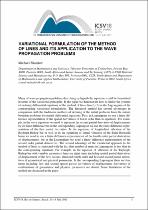 ResearchSpace
ResearchSpace
Variational formulation of the method of lines and its application to the wave propagation problems
JavaScript is disabled for your browser. Some features of this site may not work without it.
- ResearchSpace
- →
- Research Publications/Outputs
- →
- Conference Publications
- →
- View Item
| dc.contributor.author |
Shatalov, M

|
|
| dc.date.accessioned | 2012-06-27T09:24:51Z | |
| dc.date.available | 2012-06-27T09:24:51Z | |
| dc.date.issued | 2011-07 | |
| dc.identifier.citation | Shatalov, M. Variational formulation of the method of lines and its application to the wave propagation problems. 18th International Congress on Sound and Vibration (ICSV 18), Rio de Janeiro, Brazil, 10-14 July 2011, pp 1873-1880 | en_US |
| dc.identifier.isbn | 978-1-61839-259-6 | |
| dc.identifier.issn | 978-85-63243-01-0 | |
| dc.identifier.uri | http://toc.proceedings.com/13257webtoc.pdf | |
| dc.identifier.uri | http://hdl.handle.net/10204/5949 | |
| dc.description | Copyright: International Institute of Acoustics and Vibration (IIAV). Originally published in the 18th International Congress on Sound and Vibration (ICSV 18), Rio de Janeiro, Brazil, 10-14 July 2011, pp 1873-1880 | en_US |
| dc.description.abstract | Many of wave propagation problems describing by hyperbolic equations could be formulated in terms of the variational principles. In the paper we demonstrate how to derive the systems of ordinary differential equations of the method of lines directly from the Lagrangians of the corresponding variational formulations. The discussed method has several advantages in comparison with the traditional methods of deriving of the initial problems from the initial-boundary problems for partial differential equations. First, in Lagrangians we use a finite difference representation of the spatial derivatives of lower order than in equations. For example, in the wave equations we need to represent the second partial derivative of displacements by its finite difference but in the corresponding Lagrangian we use the finite difference representation of the first partial derivative. In the equations of longitudinal vibration of the Rayleigh-Bishop bar as well as in the equations of lateral vibration of the Euler-Bernoulli beam we need to use a finite difference representation of the fourth order partial derivatives of displacements, but in the Lagrangians we need a finite difference representation of the second order partial derivatives. The second advantage of the variational approach to the method of lines is connected with the fact that number of terms in Lagrangians is less than in the corresponding equations. For example, in the equation of vibration of the Rayleigh-Bishop bar with variable parameters there are eight terms including spatial partial derivatives of displacement of the first, second, third and fourth order and first and second partial derivatives of geometrical and physical parameters. In the corresponding Lagrangian there are four terms including first and second spatial partial derivatives of displacement, derivatives of combinations of geometrical and physical parameters are absent. Some limitations of the method are discussed in the paper. | en_US |
| dc.language.iso | en | en_US |
| dc.publisher | Curran Associates | en_US |
| dc.relation.ispartofseries | Workflow;8509 | |
| dc.subject | Wave propagation | en_US |
| dc.subject | Lagrangians | en_US |
| dc.title | Variational formulation of the method of lines and its application to the wave propagation problems | en_US |
| dc.type | Conference Presentation | en_US |
| dc.identifier.apacitation | Shatalov, M. (2011). Variational formulation of the method of lines and its application to the wave propagation problems. Curran Associates. http://hdl.handle.net/10204/5949 | en_ZA |
| dc.identifier.chicagocitation | Shatalov, M. "Variational formulation of the method of lines and its application to the wave propagation problems." (2011): http://hdl.handle.net/10204/5949 | en_ZA |
| dc.identifier.vancouvercitation | Shatalov M, Variational formulation of the method of lines and its application to the wave propagation problems; Curran Associates; 2011. http://hdl.handle.net/10204/5949 . | en_ZA |
| dc.identifier.ris | TY - Conference Presentation AU - Shatalov, M AB - Many of wave propagation problems describing by hyperbolic equations could be formulated in terms of the variational principles. In the paper we demonstrate how to derive the systems of ordinary differential equations of the method of lines directly from the Lagrangians of the corresponding variational formulations. The discussed method has several advantages in comparison with the traditional methods of deriving of the initial problems from the initial-boundary problems for partial differential equations. First, in Lagrangians we use a finite difference representation of the spatial derivatives of lower order than in equations. For example, in the wave equations we need to represent the second partial derivative of displacements by its finite difference but in the corresponding Lagrangian we use the finite difference representation of the first partial derivative. In the equations of longitudinal vibration of the Rayleigh-Bishop bar as well as in the equations of lateral vibration of the Euler-Bernoulli beam we need to use a finite difference representation of the fourth order partial derivatives of displacements, but in the Lagrangians we need a finite difference representation of the second order partial derivatives. The second advantage of the variational approach to the method of lines is connected with the fact that number of terms in Lagrangians is less than in the corresponding equations. For example, in the equation of vibration of the Rayleigh-Bishop bar with variable parameters there are eight terms including spatial partial derivatives of displacement of the first, second, third and fourth order and first and second partial derivatives of geometrical and physical parameters. In the corresponding Lagrangian there are four terms including first and second spatial partial derivatives of displacement, derivatives of combinations of geometrical and physical parameters are absent. Some limitations of the method are discussed in the paper. DA - 2011-07 DB - ResearchSpace DP - CSIR KW - Wave propagation KW - Lagrangians LK - https://researchspace.csir.co.za PY - 2011 SM - 978-1-61839-259-6 SM - 978-85-63243-01-0 T1 - Variational formulation of the method of lines and its application to the wave propagation problems TI - Variational formulation of the method of lines and its application to the wave propagation problems UR - http://hdl.handle.net/10204/5949 ER - | en_ZA |





